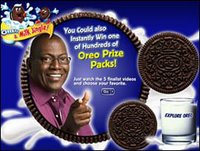
One more comment regarding Bob Garfield’s critique of Oreos advertising (Essays 830, 823 and 820)…
>It didn’t even enter my mind that this would be a racist ad. A stupid ad, yes, but not racist. So there should be NO blacks in Oreo advertisements because fools in the eighth grade choose to make a negative association? What about Aunt Jemima or KFC? Bob, I respect your opinion and generally agree with you. But to condemn this ad because you make the connection between Oreo and childish racist comments comes across as... somewhat racist. Maybe if you had allowed an actual black individual [to] review this ad in collaboration with you, it would hold water. But, because you’ve applied ugliness to this ad that isn’t overtly there, it says more about the reviewer than the Oreo spot.
— New York City, NY

Special Bonus! Here’s a story that appeared last month in response to the Oreo Controversy. The most outrageous item in the piece: Referring to Bob Garfield as the Roger Ebert of the ad trade. The second-most outrageous item: Garfield’s asinine commentary.
Idol judge’s oreo ad called out of tune
Commercial exploits racial stereotypes: critics
By Misty Harris, CanWest News Service
American Idol’s Randy Jackson is at the centre of an Oreo cookie controversy incited by a TV ad some say exploits racial stereotypes.
The commercial, which promotes an Oreo-sponsored talent contest, features Mr. Jackson being hounded by wannabe pop stars who sing, rap and holler “Oreo!” at the black Idol judge.
Oreo is a widely recognized epithet describing an African-American who has shunned black culture to curry favour with the white majority. The term was inspired by the cookie’s appearance: black on the outside, white on the inside.
Critics of the campaign include leading academic and advertising figures who charge that Nabisco and the Idol judge are reckless in highlighting the connection between a commercial product and a racial slur.
“It just amazes me that Randy Jackson and Nabisco would put themselves in this position,” says Advertising Age columnist Bob Garfield, the Roger Ebert of the ad trade.
“Now if Randy had played with the racial subtext in some way, that would have been a different matter. That would have been pretty hilarious, actually, flipping the bird at his jackass critics. But in the ad, it’s as if he and everybody else were completely unaware of the double entendre.”
Advertising critic Steve Hall acknowledged the cookie controversy on Thursday on his blog AdRants.
“Of course there’s nothing wrong with Randy Jackson hosting the contest but ... to see fellow African-Americans appear to be calling Jackson an ‘Oreo’ in the ad is either a perpetuation of the stereotype or a brilliant twist on the stereotype that gleefully casts aside political correctness and goes for daring humour,” Mr. Hall writes.
A spokeswoman for Kraft, Nabisco’s parent company, said she is not aware of any discussion by the company's marketing team about the double meaning of Oreo, or of the word being interpreted negatively in the context of the ad.
“Oreo’s program is all about music,” said Laurie Guzzinati. “Randy’s involvement is all about the musical aspect and the celebration of the [brand’s] jingle.”
Tricia Rose, a professor of Africana studies at Brown University, believes this line of reasoning is a way of evading responsibility.
“By claiming to be colour blind when racial discrimination is widespread, you actually reinforce the pervasive and misunderstood reality of racial discrimination and work to maintain it,” said Ms. Rose, who believes Mr. Jackson entered the partnership knowing “full well what the pun is about.”
She contends the Oreo commercial hides behind the assumption that to mention race is to be racist.
“There’s a presumption that we’re past certain types of racism and that you can use these terms now in a tongue-in-cheek way,” she said. “[So] it’s very hard to fight this sort of thing because you look too serious, you look old-fashioned, like you’re overreacting to a harmless joke.”
Previous examples of marketers using what Ms. Rose calls the “old language of racism” in a seemingly ironic way include the recent Adidas Y1 Huf -- a sneaker that drew sharp criticism for its depiction of a yellow-faced youth with bowl-cut hair, a pig nose and buck teeth.

No comments:
Post a Comment